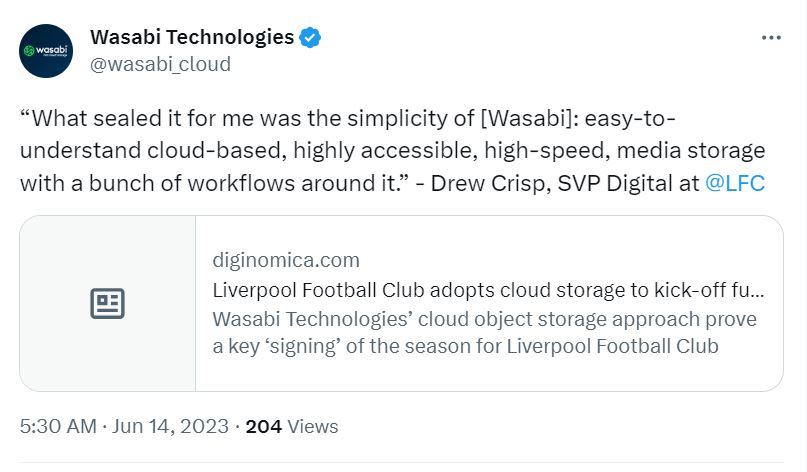
The transition from tape to disc to fully digitized formats in the industry for one has definitely created a demand not only for better storage solutions. (Image source – Shutterstock)
Data storage for the media and entertainment industry
|
Getting your Trinity Audio player ready... |
Data storage for the media and entertainment industry can be rather complex and challenging. Given that both these industries continue to face unprecedented challenges in the digital era, utilizing the cloud for data storage would make the most sense. The demand for high-quality content, the proliferation of formats and platforms, the need for scalability and agility, and the threat of cyberattacks are some of the factors that put pressure on the industry’s data management capabilities.
The transition from tape to disc to fully digitized formats in the industry for one has definitely created a demand not only for better storage solutions but also for backup and recovery services that are capable to work at faster speeds. This meant that the media and entertainment industry would look to leverage the cloud to provide it with the data storage solutions needed.
To cope with these challenges, media and entertainment companies needed to also adopt backup and recovery solutions that can ensure the availability, integrity, and security of their data assets. These solutions should enable them to:
- Protect their data from loss or corruption due to human error, hardware failure, natural disaster, or malicious attack. Data loss can have devastating consequences for the industry, such as reputational damage, legal liability, lost revenue, and missed deadlines.
- Restore their data quickly and efficiently in case of a disaster or outage. Downtime can be costly for the industry, as it can disrupt production workflows, affect customer satisfaction, and compromise competitive advantage.
- Leverage their data for business value by enabling data analytics, artificial intelligence, and machine learning. These technologies can help the industry gain insights, optimize operations, enhance creativity, and improve customer experience.
While adopting the cloud was not a big problem for most organizations in the media and entertainment industry, making the right choices on how to use the cloud was still a big challenge.
There is no denying that streaming platforms and cloud-native media and entertainment organizations were able to make the most of the cloud. From programming to storage, these companies had the right tools and were able to provide customers with what they needed.

69% of media and entertainment companies have been using cloud storage for three years or less. (Image source – Shutterstock)
The digitalization of the media and entertainment industry
However, for traditional media and entertainment companies, the transition was a challenge. Yet they were not giving up. According to a survey by Wasabi Technologies, while media and entertainment organizations are still relatively new to cloud storage (69% of respondents had been using cloud storage for three years or less), public cloud storage use is on the rise, with 89% of respondents looking to increase (74%) or maintain (15%) their cloud services.

Michael King, Vice President GM Asia Pacific and Japan at Wasabi Technologies.
The survey, commissioned by Wasabi in late 2022 involved 1,000 IT decision-makers including 140 from the media and entertainment industry with the aim of understanding how media owners leverage cloud storage as part of their overall IT strategy.
Survey findings highlighted respondents stating they allocate 13.9% of their IT budgets to public cloud storage services, on average. However, overdrawn budgets due to hidden fees, alongside cybersecurity and data loss concerns, remain problematic for media and entertainment organizations.
“When it comes to storage in the media and entertainment industry, it is really primed for moving to the cloud. And it is not only in the entertainment space. The change of the consumers who are using more OTT, and content in social media, the amount of video and the amount of data that needs to be consumed, is almost beyond the point of having an on-premises model. At the same time, the pandemic created a new work environment.
So, it’s a segment that has lots of integral players. But it’s very strong in terms of having the point solutions. And I think where we see is there’s increased collaboration across that ecosystem to deliver things for customers. Storage is a fundamental part of it and there are the components around it to make it really all work,” explained Michael King, Vice President GM Asia Pacific and Japan at Wasabi Technologies.

Wasabi Technologies is cloud storage partner for Liverpool FC.
Data storage in backup and recovery for content
King also pointed out that the media and entertainment industry does not only mean broadcast and entertainment companies. It in fact refers to any company that has content that needs to be backed up.
For example, in the sports industry, King mentioned that a lot of teams are moving to a digitalization process whereby Wasabi is the backend infrastructure for not only storing the videos but also trying to edit them and make them available in a cost-effective way. Some of Wasabi’s clients include Liverpool FC and Boston Red Sox. In Asia, King also highlighted that Wasabi is currently in conversation with several local sporting teams.
“I think we’re seeing next besides the TV stations and movie studios; production houses are also looking at really moving from tape to digital content. With digitalization, they can monetize the data as well,” added King.
King’s views echo the findings of the survey. Media and entertainment respondents have indicated increasing their public cloud storage budgets in the next 12 months. They cited new data security, backup and recovery requirements as the top reason driving the increase, compared to the global average where security ranked third.
Interestingly, almost half (45%) of media and entertainment organizations reported using more than one public cloud provider. Data security requirements were one of the top reasons why these organizations were choosing a multi-cloud strategy, ranking a close second (44%) to different buying centers within the organization making their own purchase decisions (47%).

Responses show a strong indication of cloud services growth over the next 12 months. (Source – Wasabi Technologies)
Moreover, the top three biggest security concerns media and entertainment organizations have with public cloud include:
- Lack of native security services (42%)
- Lack of native backup, disaster, and data protection tools and services (39%)
- Lack of experience with cloud platforms or adequate security training (38%)
“Attacks are everywhere. And recently, there’s been cyberattacks targeting the media and entertainment space. We think it’s fundamental to have multiple copies of backup. It’s not just having copies in multiple locations but having immutability and object where people can touch and edit,” said King.
Globally, cyberattacks in the media and entertainment industry have been increasing. A recent example would be the vulnerability in MOVEit file transfer program, whereby the BBC was a victim. Another example involved Singapore’s Mediacorp whereby 14,000 meconnect users had their login credentials compromised.
The most famous cyber attack in the media and entertainment industry involved Sony Pictures in 2014. The film company suffered a high-profile cyber attack that resulted in the theft and release of sensitive company information, including employee data and unreleased films. The attack was attributed to North Korean hackers and caused significant damage to Sony Pictures’ reputation and finances.
Wasabi Technologies: The hottest cloud data storage
For King, the industry needs to have affordable data storage for all content in the cloud, from raw footage to finished product, securely archived and be able to get access to it at a moment’s notice.
“If you look at Wasabi, there’s really three key selling points. One is price competitiveness. But it’s not just the initial price. It’s really our fundamental pricing structure strategy is we have no egress or no ingress charges. There’s no vendor lock-in as well. And it’s not only cost competitive, but it’s predictable.
One of the things we’re hearing from the customers is that it’s not only the price, but it’s the predictability of the price. At the end of the month, they know what the price will be. And so that’s a huge component of us. Our breakthrough hot cloud storage technology enables us to offer one simple, single tier of service that’s blazingly fast yet at only 1/5th the cost of AWS S3, Google Cloud, or Microsoft Azure.
The next is the performance, the speed, the reliability, especially in the entertainment industry. They have large files and we make sure that they have the right latency, and they have the data in the right place, as well as have the right partnerships in place.
The third is the protection or more toward the cost or the predictability. The cost is important, not only for the customer but for the partner. We don’t really sell direct, but we go through partners. And we provide partners the margin to be able to provide that solution to their customers,” commented King.
With that said, the media and entertainment industry should evaluate their backup and recovery needs and choose the best solution that suits their budget, infrastructure, and objectives. By doing so, they can ensure the protection and recovery of their data assets and leverage them for business value.
READ MORE
- Safer Automation: How Sophic and Firmus Succeeded in Malaysia with MDEC’s Support
- Privilege granted, not gained: Intelligent authorization for enhanced infrastructure productivity
- Low-Code produces the Proof-of-Possibilities
- New Wearables Enable Staff to Work Faster and Safer
- Experts weigh in on Oracle’s departure from adland
